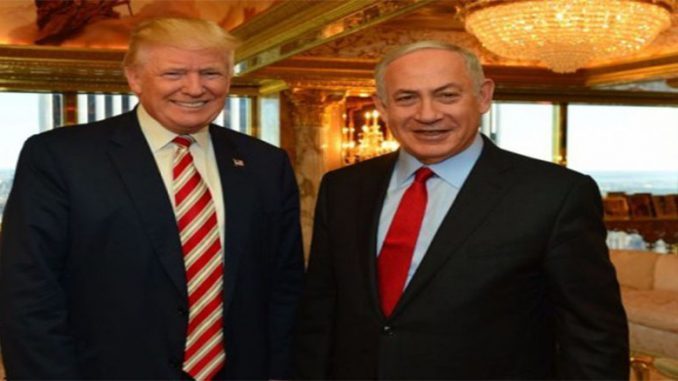
Palestinian President Mahmoud Abbas will speak in the United Nations Security Council in the next two weeks about the U.S. Middle East peace plan, Palestinian U.N. envoy Riyad Mansour said on Wednesday.
Mansour told reporters he hoped the 15-member Security Council, at the same meeting that Abbas would address, would vote on a draft resolution on the Israeli-Palestinian peace plan unveiled by U.S. President Donald Trump on Tuesday.
However, the United States is certain to veto any such resolution, diplomats said, allowing the Palestinians to take the draft text to the 193-member U.N. General Assembly, where a vote would publicly show how Trump’s peace plan has been received internationally.
“We will try our best with our friends to have the strongest possible draft resolution and to receive the strongest and largest possible voting in favor of that resolution,” Mansour said. He did not give details of what might be in the text.
“Of course we would like to see a strong, large opposition to this Trump plan,” he said with Tunisian U.N. Ambassador Moncef Baati, currently serving a two-year term on the Security Council, standing beside him.
He said Abbas would use his visit to the United Nations in New York to “put before the entire international community the reaction of the Palestinian people and the Palestinian leadership against this onslaught against the national rights of the Palestinian people by the Trump administration.”
Israel’s U.N. mission signaled on Tuesday that it was preparing for the Palestinians to pursue U.N. action, saying in a statement that it was “working to thwart these efforts, and will lead a concerted diplomatic campaign with the U.S.”
The Palestinians could push the U.N. Security Council to condemn the American peace plan or elements of it such as an Israeli move to apply jurisdiction to West Bank settlements and the planned recognition of that by the United States.
A U.S. veto of such a Security Council resolution would then allow the Palestinians to convene an emergency special session of the General Assembly to discuss the same issue and vote on a similar resolution. General Assembly resolutions are nonbinding, but carry political weight.
The General Assembly held an emergency special session in December 2017, at the request of Arab and Muslim countries, on Trump’s decision to recognize Jerusalem as Israel’s capital.
At that meeting the General Assembly adopted a resolution calling for Trump’s declaration to be withdrawn. Days earlier a similar draft text had been vetoed by the United States in the 15-member U.N. Security Council.
A total of 128 countries backed the General Assembly resolution, nine voted against and 35 abstained. Twenty-one countries did not cast a vote. Trump had threatened to cut off financial aid to countries that voted in favor.
Under a 1950 resolution, an emergency special session can be called for the General Assembly to consider a matter “with a view to making appropriate recommendations to members for collective measures” if the Security Council fails to act.
The Palestinians followed the same path in June 2018. The General Assembly condemned Israel for excessive use of force against Palestinian civilians, adopting a resolution with 120 votes in favor, eight against and 45 abstentions.
The resolution was put forward in the General Assembly by Arab and Muslim states after the United States vetoed a similar resolution in the Security Council.
What to Know About Trump’s Middle East Plan
The proposal, three years in the making, favored Israeli priorities and was conceived without Palestinian input. The New York Times on Jan. 29 published the main points of the Trump’s proposed peace plan as follows:
President Trump stood alongside Prime Minister Benjamin Netanyahu of Israel at the White House on Tuesday to reveal a long-awaited plan intended to resolve generations of conflict between Israelis and Palestinians.
Noticeably absent from that announcement, though, was any Palestinian representation, and Palestinian leaders have flatly rejected the plan. The proposed settlement strongly favors Israeli priorities rather than having both sides make significant concessions.
Mr. Trump vowed at the start of his presidency that he would negotiate a “bigger and better deal” to broker peace than anyone could imagine. Three years later, experts say that the plan, developed under the supervision of Jared Kushner, Mr. Trump’s son-in-law, falls remarkably short of that goal and is unlikely ever to become the basis for a peace agreement.
What does the plan say?
While Mr. Trump’s proposal is the latest in a series of United States-brokered attempts to forge peace between Israelis and Palestinians, his framework was a sharp departure from decades of American policy. The United States has long voiced support for the creation of a Palestinian state with only slight adjustments to the Israeli boundaries that existed before the Arab-Israeli war of 1967, when Israel wrested the West Bank from Jordan, and Gaza from Egypt.
Instead, the 181-page Trump plan proposes a West Bank riddled with interconnected chunks of Israeli territory containing Jewish settlements, many of them largely encircled by Palestinian lands. For the Palestinians, it would mean giving up a claim to large amounts of West Bank land — including places where Israel has built settlements over the past half-century and strategic areas along the Jordanian border. Most of the world regards the settlements as illegal.
The framework also sets aside the longtime goal of a fully autonomous Palestinian state. Instead, Mr. Trump vaguely promised that Palestinians could “achieve an independent state of their very own” but gave few details, while Mr. Netanyahu said the deal provided a “pathway to a Palestinian state” with significant caveats.
The Palestinians do not subscribe to the plan, though the deal provides for a four-year window for them to engage in renewed settlement talks. During that time, Israel would refrain from constructing settlements in those parts of the West Bank that the plan has designated for Palestinians.
Previous American proposals spoke of uprooting tens of thousands of Israelis from the settlements to return those areas to the Palestinians for inclusion in their state, but the Trump plan promises to leave both settlers and Palestinians in their current homes. Rather, it maps out a series of linked settlements and other areas that would officially become Israeli territory in the midst of the West Bank.
The plan also envisaged a Palestinian capital in “eastern Jerusalem,” on the outer edges of the city beyond Israel’s security barrier, while guaranteeing Israeli sovereignty over all of Jerusalem. The city is a holy site for the Jewish, Muslim and Christian faiths and has long been a sticking point in peace negotiations.
Mr. Netanyahu later clarified that the proposed Palestinian capital would be in Abu Dis, a Palestinian village on the outskirts of the holy city.
The plan proposes transportation links between the unconnected Palestinian territories in the West Bank and Gaza. But the element of the plan that may prove to be its only lasting effect is American recognition of Israel’s claim over the Jordan Valley and all Jewish settlements in the West Bank.
How would this redraw the map of Israel?
The proposal gives American approval to Israel’s plan to redefine the country’s borders and formally annex settlements in the West Bank and the Jordan Valley that it has long sought to control.
That would leave the West Bank portion of any potential Palestinian state surrounded on all sides by Israel. Israeli forces seized the West Bank from Jordan during the 1967 war, and Israeli settlements have steadily encroached on the region over the decades since, a move largely condemned internationally.
Mr. Netanyahu caused controversy in September when he vowed, while running for re-election, to annex the Jordan Valley, a strategically critical chunk of the occupied West Bank nestled against the border with Jordan. On Tuesday, he made it clear that he saw President Trump’s plan as giving legitimacy to claiming Israeli settlements and the Jordan Valley as Israeli territory.
“For too long, the very heart of the land of Israel where our patriots prayed, our prophets preached and our kings ruled has been outrageously branded as ‘illegally occupied territory,’” Mr. Netanyahu said. “Well today, Mr. President, you are puncturing this big lie.”
Mr. Netanyahu said that his cabinet could move within days to assert sovereignty over those areas, but the decision could be subject to legal challenges because the current government is an interim administration.
What has the Palestinian reaction been?
Despite Mr. Trump’s assertion that the deal was “a win-win opportunity” for both sides, Palestinians have largely rejected it.
Mahmoud Abbas, the 84-year-old leader of the Palestinian Authority, condemned the plan in a speech on Tuesday evening, calling it a “conspiracy” not worthy of serious consideration.
“We say a thousand times over: no, no, no,” Mr. Abbas said, speaking from Ramallah in the West Bank.
The Palestinian leadership cut off communication with the Trump administration in 2017 after Washington recognized Jerusalem as Israel’s capital and later moved the American Embassy to the city. On the streets of Gaza and the West Bank, protests against the plan broke out on Tuesday.
The reaction from other Arab governments has been mixed. None of the United States’ Arab allies have formally endorsed the plan or committed to ushering it into reality, though ambassadors from Bahrain, Oman and the United Arab Emirates attended the announcement.
Was the focus peace or politics?
David Friedman, the United States ambassador to Israel, said in a call with reporters after the plan was announced that the big reveal was timed in a “nonpolitical way.”
He said that the plan was “fully baked” before an Israeli election last April but that American officials had held off introducing it then. When that election produced no government, the United States again postponed any announcement until after a second election in September, he said.
Now, as Israel approaches a third election in less than a year, which could also fail to produce a government, Mr. Friedman said that the time had been right to introduce the proposal. He noted that American officials had also discussed the plans with Benny Gantz, the leader of the centrist Blue and White Party and Mr. Netanyahu’s main rival in the March 2 election.
But experts say that the timing of the rollout has more to do with the domestic politics of the United States and Israel than with resolving the conflict, with Mr. Trump facing an impeachment trial and Mr. Netanyahu facing trial on corruption charges.
William F. Wechsler, director of Middle East programs at the Atlantic Council, a Washington-based research organization, said in an emailed statement that the plan was unlikely to have a major impact in the short term.
“The announcement’s chosen timing, specific staging, limited participants, and indeed its substance make clear that it has less to do with a good-faith effort to reach peace between Israelis and Palestinians,” Mr. Wechsler said, “and more to do with the immediate legal and electoral challenges that confront both leaders.”



